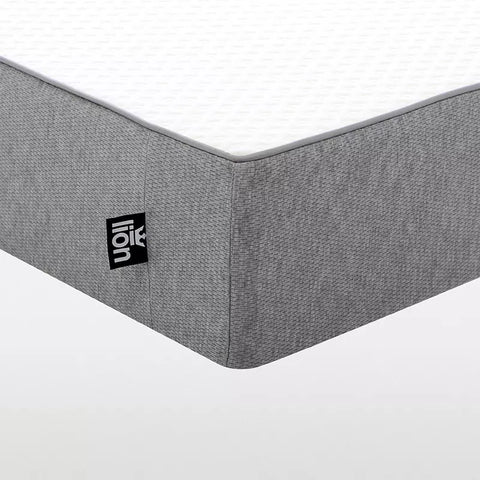Memory Foam Mattress Technical Specifications
| Mattress Name | Memory Foam Mattress |
| Foam Grades | 50kg/m3 memory foam combined with 36kg/m3 support layer |
| Cover Type | Coolmax Cover |
| Fire Retardancy | BS7177 |
| Warranty | 5 years foam / 1 years cover |
| Mattress Size | Double |
| Dimensions | 190cm (Length) x 135cm (Width) x 21cm (Height) |
Memory Foam Mattress Features & Benefits
• Luxury 50kg/m3 memory foam combined with our 36kg/m3 support layer.
• In Stock Ready for Despatch
• Choose Your Delivery Date
• Excellent For Reducing Back Pain
• Pressure Reducing Technology
• Anti-Microbial / Dust Mite Resistant Naturally
• Anti-Allergenic / Improves Blood Circulation
• Luxury Machine Washable Cover
• 5 Year Guarantee
• Coolmax Temperature Regulating Fabric
Memory Foam Mattresses
Nothing feels as good as a good night’s rest, especially if you have trouble falling or staying asleep. Not only does it help you to feel ready, energized and focused for your day, it is essential in order to maintain a healthy lifestyle. If you’re having trouble sleeping night after night, it may be time to retire that old spring mattress and trade it in for a memory foam mattress instead.
Did you know the main reason spring or “coil” mattresses are still manufactured is simply because they’re cheap to construct and to buy? The technology behind a spring mattress hasn’t really changed much in quite some time, so any spring mattress you buy today is sure to be the same as the one you bought brand new 10 years ago. However, newer technology offers benefits you just won’t get with a spring mattress.
What is Memory Foam?
First designed in the mid-1960s and originally intended for NASA airplane seats, memory foam is made from a highly energy absorbent, soft material called viscoelastic. The material molds to the body in response to heat and pressure, distributing weight evenly, and returning to its original shape as soon as the pressure is removed. Because it was created to protect against impact, it is extremely comfortable and beneficial for sleeping. It has even been used as cushioning in helmets and shoes and in prosthetics to prevent ulcers for the disabled.
Today, just about everyone has at least heard of memory foam. It’s used in pillows, mattresses and mattress pads, coming in varying densities and depths for optimal comfort. But because sleep is subjective, preferences on sleep surfaces are individual whether it’s firm, hard, or soft. Thus, memory foam mattresses are able to reflect this. Different levels and variations of memory foam mattresses are out there ranging from soft to firm, cold to hot, and slow to fast recovery time, always depending on the brand, type, texture, thickness, etc.
A memory foam mattress may be a good idea, especially if:
• You experience back and/or joint pain.
• You have issues with pressure points/pressure sores.
• You often toss and turn at night.
• Innerspring and pillow-top mattresses lose comfort too quickly for you.
• Your partner’s movements wake you up at night.
Mattress Support Comparison
While spring mattresses may seem comfortable at first, especially with fancy pillow-tops, they do not offer pressure point relief. This means the body does not lie evenly and the blood cannot circulate completely, which often causes pain in the hips and back region. Because spring mattresses push back against your body, the proper support is impossible. Thus, they result in pressure points which lead to poor blood circulation, tossing and turning, as well as aches and joint pain. And any of the support your trusted spring mattress did achieve when you bought it will be reduced by 16 percent in the first year alone, so it will just keep getting worse over time until you eventually give in a purchase a brand new one a few years down the line.
On the other hand, a good quality memory foam mattress distributes body weight evenly. According to sleep specialist Donna L. Arand, PhD, “when you lie on the memory foam, the heat from your body softens it in appropriate points,” helping to “support your body along the curves and natural lines of the body.”
The simple claim can be measured by the differences in the mattresses themselves. In the healthcare industry, pressure is measured in mmHg, with anything lower than 32mmHg being considered a pressure relieving sleep source. Memory foam mattresses are measured in the teens with the lowest on the market being 12.43mmHg at 200 lbs. of pressure. Spring mattresses measure in the 30’s on average. So not only are pressure points significantly reduced up to 80 percent, users sleep better as a result.
Because pressure points are reduced, there’s less tossing and turning throughout the night. Even if your partner moves around a lot in their sleep, a memory foam mattress could help to minimize the extra movement, making you less aware of their movements and helping reduce the number of times you awaken during the night, something a coil mattress just can’t achieve.
Mattress Firmness
Traditional spring mattresses basically act as a shock absorber, reducing the wear and tear of the mattress itself while the coils determine the firmness or actual support. Therefore, the fewer coils there are, the thicker the springs need to be to make up for the difference. The coils then vary depending on size, so coils that are 1.63mm to 1.37mm in gauge will give more easily to pressure while a 1.94mm gauge coil feels firm. Therefore, a specific mattress’ firmness can be determined based on the coils themselves.
Memory foam mattresses can range is varying degrees from soft to firm. Because of the abundance of technology available to manufacturers, the levels of firmness is far more accurate than that of a coil spring and there are far more choices in regards to firmness.
Memory foam mattresses are able to distribute body weight evenly, so a good memory foam mattress should supply a firm feeling without compromising the back, hips, and joints as is seen with traditional mattresses. Because they’re able to form fit the individual person as it comes into contact with their body heat, these mattresses essentially detect the areas that require more support, cradling your body as it requires and offering custom support as if it were specifically designed with you in mind.
They also come in varying degrees of firmness, and are able to be constructed to reflect these options, offering levels spring mattresses just can’t completely achieve.
Temperature Sensitivity Mattresses
While spring mattresses don’t adjust to body temperature unless they come topped with memory foam, the temperature of the bedroom makes no difference at all. Since memory foam mattresses completely rely on detecting body heat, it is possible for it to display a delayed response if the room is cold. At freezing point, the average foam becomes rock hard, but it would be rare for the mattress to actually achieve the temperature needed in order for this to take place.
However, it can be a con because the colder a room is, the longer it could take the memory foam to adjust to your body heat. But the essential benefits of memory foam mattress are really worth the wait if you were to ever even experience this at all. Depending on the type of memory foam you’ve selected, they vary in recovery time. For instance, traditional and cheaper memory foam options will have the slowest recovery time while gel memory foam is a little faster, with plant-based memory foam being the fastest option.
Additionally, memory foam is able to retain heat, providing extra warmth and added comfort for cold months (thus actually combating your chances of ever having a problem with delayed response times unless, of course, your memory foam mattress were outside in the snow for whatever reason).
Some mattresses even come with a cooling feature for those that are typically warm-blooded. That way, users can determine their own level of comfort based on personal temperature preferences as well.
Maintenance
When it comes to the time degrees in which mattresses need to be replaced, memory foam will last longer than a traditional mattress. Therefore, any added price in buying the mattress is repaid in time as it lasts longer.
Spring mattresses must be replaced every 3-10 years (8 years on average, depending on the specific mattress type and brand) which creates a fantastic reoccurring income for the big mattress companies. They must also be rotated about once every three months for even wear and comfort whereas memory foam mattresses never need to be flipped or rotated.
Essentially, there is no maintenance required in the slightest. Memory foam mattresses last much longer as well, averaging 5-15 years depending on the construction. Thus, the warranties associated with most memory foam mattresses are available longer and are more extensive as the materials are far superior to spring mattresses. Most brands offer around 10 years of full coverage in their warranties, something you just won’t find with a spring mattress.
Main benefits of a memory foam mattress
• Say goodbye to back, neck or shoulder pain. As you get the added natural support you need, costing little to no effort on your part.
• Various aches, pains and soreness will dissipate, allowing the body to recover more quickly from injuries as well. As areas in pain have a slightly higher temperature than the rest of the body, and memory foam detects heat differences, it will mold to the body, adding or reducing pressure to areas as needed.
• As the technology works with your personal body heat, it supports pressure points specific to you. It’s like a personalized mattress, conforming to support your every move.
• You’ll sleep better, tossing and turning less.
• Ideal sleeping posture can be attained as the mattress assists proper spinal alignment when lying down, preventing any future pain as well.
• By providing proper elevation to the head during sleep resulting in a proper and healthy pattern of breathing during sleep, sleep apnoea problems are relieved.
• If your partner moves, you won’t feel it as easily because the material is energy absorbent.
• There are more choices when it comes to levels of firmness. Thus, you can finally find the perfect level specifically for you.
• While some are able to retain heat, others offer a cooling feature, allowing you to personalize your comfort based on temperature-controlled preferences.
• There is no maintenance and no need to flip the mattress every few years.
• Overall, you’ll do the environment a favor.
• According to the Environment, Health and Safety Online, a typical mattress that has been used for years contains 100,000 to 10 million dust mites inside while memory foam mattresses are composed of polyurethane foam makeup, which is made of fibers that prevent allergy-causing dust mites from collecting within the bed. The dense composition of the foam even helps prevent the accumulation of allergens over time while organic fibers like cotton actually attract dust mites that feed off dead skin.
• Memory foam mattresses last longer, and have longer warranties, saving you time replacing old mattresses and tons of money in the long run.
The Better Sleep Council suggests quality mattresses should provide 8-10 years of good support and comfort, and with the average person spending at least 30 percent of their life in bed, the importance of a healthy and supportive mattress should not be dismissed.
A good memory foam mattress has so much more to offer. They’re durable, supportive, and provide the pressure-less effect that so many people look for and benefit from. With new technology comes better sleeping options that offer the best benefits, overall promoting the best sleep and healthiest lifestyle.


